Uncategorized
‘Where do I stand?’ Queer Modern Orthodox teens navigate a changing world
This article was produced as part of JTA’s Teen Journalism Fellowship, a program that works with Jewish teens around the world to report on issues that affect their lives.
(JTA) — Until recently, Jacob Feldon considered Yeshiva University a serious candidate for his college education. As a senior at a Utah high school who has embraced Modern Orthodoxy and harbors dreams of potentially becoming a rabbi, he said he was drawn to “the idea of going to school in an observant community where I can study Torah and Talmud with some of the smartest people doing such a thing today.”
But Feldon is also bisexual and serves as a Jewish youth ambassador for Beloved Arise, a national interfaith support organization for queer youth. So Feldon took notice when Yeshiva University declined to officially recognize a Pride Alliance group on campus, and then pressed its case to the U.S. Supreme Court when mandated to do so.
“As a queer man I can’t see going into that environment right now with everything happening,” Feldon told the Jewish Telegraphic Agency. “I’m getting a pretty clear message that I won’t be welcomed, authentically welcome.”
Feldon is not the only high school student who identifies as Modern Orthodox to have complicated feelings about Yeshiva University at the moment. As the main Modern Orthodox university, the school blends secular and religious instruction and values. Its attempt to navigate a balance between being welcoming and inclusive and fighting for the right to control LGBTQ students’ official expression on campus has made national headlines — and caused some Modern Orthodox teens to question whether they would feel comfortable attending.
For LGBTQ teens, the lawsuit and other controversies around gender and sexuality in Modern Orthodoxy have created “a little hopelessness,” said Rachael Fried, executive director of the support nonprofit Jewish Queer Youth.
Fried described the mindset of Modern Orthodox LGBTQ adolescents as, “I’m trying to live an Orthodox life. I’m trying to build my future as a queer Orthodox person, and this is what the main, flagship institution of Modern Orthodoxy thinks about me. Then where is my future and what’s the hope for me and what are my dreams?”
For queer teens, the Y.U. saga is just one high-profile touchpoint in an ongoing grappling with their place within Modern Orthodoxy. Modern Orthodox communities range widely in many ways depending on their history, geography and leadership, meaning that some queer Orthodox teens say they have found acceptance and support while others say they’ve had more challenging experiences.
Rachael Fried is the executive director of the support nonprofit Jewish Queer Youth. (Courtesy JQY)
Often teens say they experience both. Like many of the queer teens interviewed for this article, Rivka Schafer and their parents first thought it best to keep their queer identity private due to the repercussions they feared with being LGBTQ in a Modern Orthodox community. When they did come out in middle school, Schafer said they received mixed reactions in their Jewish day school.
“The kids had a lot of stigma and the administration did too, but they tried to be really accepting and really supportive which was also really, really beautiful,” Schafer told JTA.
“Currently I identify as Modern Orthodox because Judaism is a really important part of my identity and I find Judaism to be really meaningful to me,” said Schafer, who is nonbinary, from their home in Teaneck, New Jersey. “So although I struggled a lot with the acceptance in the Jewish community, and stigma within the Orthodox community, I really ultimately believe it is and should be a strong part of who I am.”
But while Schafer has remained committed to their religious identity, Fried, of Jewish Queer Youth, said the Pride Alliance lawsuit and other LGBTQ-related controversies sometimes “pushes people away from Orthodoxy in a really unfortunate way.”
This is what happened to Mattie Schaffer. “I would describe it as [having] a religious identity crisis,” said Schaffer, a student at Lev Miriam Learning Studio in Passaic, New Jersey who uses he/they pronouns and identifies as queer. Schaffer, 16, said their neighborhood is a more right-wing Modern Orthodox community, colloquially called yeshivish, though his family is not.
“A part of all the alienation and isolation comes from a feeling of not having a place anywhere,” Schaffer said. “And as much as you try to conform, there just isn’t really a place for you to fit unless you want to be sticking out or be bending yourself in half.”
Modern Orthodox queer teens’ feeling “of not having a place” can be quite literal, particularly for those teens that are non-binary or transgender, said Schafer, the teen from Teaneck.
Schafer finds their nonbinary identity sometimes at odds with even the most basic rules of the Hebrew language, which assigns a gender to nearly all words, and of their synagogue. “Where do I stand? On the mechitza?” they asked, referring to the divider separating men and women in Orthodox synagogues.
The question of LGBTQ individuals in gender-separated prayer spaces recently reared up at Y.U., when one of its leading rabbis decreed that a transgender woman could not pray in either the women’s or men’s section of her university-affiliated synagogue.
But while recent months have been abundant in controversy, the last decade has shown tremendous progress for LGBTQ Modern Orthodox teens, according to multiple people in and around the community.
Rabbi Steve Greenberg, who was ordained by Yeshiva University before coming out as gay in 1999, heads the Orthodox queer advocacy group Eshel. His organization surveyed approximately 240 Orthodox synagogues and rabbis and found that 74% of interviewees were “high welcoming,” meaning that “inclusion is explicit, principled and broadly acknowledged” and queer families’ life cycle events other than marriage are celebrated. Another 22% offered “moderate welcome,” while 4% were “low welcoming/inattentive.”
Nadiv Schorer, right, married Ariel Meiri in 2020 with Orthodox rabbi Avram Mlotek officiating. (David Perlman Photography)
Approximately 10 rabbis said they were willing to perform same-sex marriages, according to Eshel’s research.
“They do their best to make it possible for LGBTQ folks to belong to Orthodox environments,” said Greenberg. “And it’s grown.”
The head of school at North Shore Hebrew Academy on Long Island, Rabbi Jeffery Kobrin, said he believed that growing conversations about LGBTQ issues in Orthodox communities has had benefits.
“I think it’s easier to be a queer teen now than it was in 2012, just because it’s more out there,” Kobrin said. “People talk about it more, people try to be more accepting of it, and people, community-wise, seem to less feel this contradiction between Orthodoxy and alternative lifestyles.”
Some teens say they have witnessed change in just the last couple of years. Benjamin Small, a gay teen who graduated from SAR High School last year and now attends Yeshivat Ma’ale Gilboa in Israel, said his rabbi, Chaim Poupko, of Congregation Avahath Torah in Englewood, New Jersey, has advocated for queer members of the Orthodox community in his synagogue.
“That would be unheard of two or three years ago,” Small said.
Few Modern Orthodox schools in the New York area have an LGBTQ support club. But Fried, JQY’s executive director, said students are learning how to organize and build community independently, in the absence of recognition from their schools and synagogues.
“That comes with people choosing themselves, feeling empowered to build their own communities and to step-up and create the groups that others are not creating for them,” she said.
Before the Y.U. court case, “the messaging that I heard from the Modern Orthodox community was ‘your identity is not wrong, and we want to support our queer members of the community,’” said Fried, whose organization gave grants to student groups affected by the Y.U. case.
But now, she said, the message that queer Modern Orthodox teens are hearing has shifted.
“Actually, your queer identity is what is problematic. It’s not just the sentence in the Torah that is about behavior, but actually your identity,” she characterized Modern Orthodox institutions as saying. “You want to gather and build community that is based around identity and that, in and of itself, is problematic, and it’s inherently a threat.”
For its part, Yeshiva University has tried to thread a narrow needle.
A person walks by the Wilf Campus of Yeshiva University in New York City, Aug. 30, 2022. (Spencer Platt/Getty Images)
“We love all of our students including those who identify as LGBTQ,” Y.U. said in a FAQ after it launched a school-sanctioned LGBTQ club. “Through our deep personal relationships and conversations with them, we have felt their struggles to fit into an orthodox world that could appear to them as not having a place for them.” (The YU Pride Alliance called the new club “a feeble attempt” at compromise and said they were not involved in its formation.)
There was no consensus among teens who spoke to JTA about how much the Y.U. saga would affect inclusion in other spaces. It’s also unclear the degree to which queer Modern Orthodox teens and their allies are incorporating the situation in their decision-making about college.
Y.U. declined to share student enrollment and admissions data, saying that the university does not generally release that information. But according to a recent Y.U. advertisement, last fall the school had “the largest incoming undergraduate class in over 20 years.”
Still, the school’s lawsuit and rhetoric has been a turnoff for 19-year-old Penny Laser, a queer student at a secular college who had envisioned possibly pursuing graduate studies in Talmud at Y.U. and grew up in a non-Orthodox household. (Laser asked to be identified using a pseudonym because she is seeking a giyur lechumra, a conversion for Jewish individuals to remove any doubt of their Orthodox Jewish legal status, and feared the Rabbinical Council of America would not grant her one if she was quoted in this article.)
“I’m not sure how I can trust or engage with Y.U. in the future,” said Laser. “A. I don’t know if it’s going to be a safe place for me, and B. I don’t want to align myself with an institution that has values like this.”
Schafer, from Teaneck, and Schaffer, from Passaic, are both not considering Y.U.
And the consequences of the Y.U. litigation goes beyond influencing the decisions of individual students, according to Fried.
“What the Y.U. situation is doing right now is forcing this conversation into the spotlight,” she said. “So different institutions and leaders are forced into having this conversation, or even thinking about where they stand. People are asking them to communicate where they stand.”
Feldon, from Utah, has hope. He thinks that the Modern Orthodox world needs queer rabbis to lead the conversation on inclusion from a halachic perspective — and he thinks that can still happen, despite the push by Modern Orthodoxy’s flagship university to block the Pride Alliance.
“I choose to believe,” said Feldon, “that we’ll get there. My dream life is where I can bring my boyfriend to minyan [prayer services] three times a day. And I choose to believe that we are on that path.”
—
The post ‘Where do I stand?’ Queer Modern Orthodox teens navigate a changing world appeared first on Jewish Telegraphic Agency.
Uncategorized
An idyllic Jewish village, full of life and hope, just hours before its utter annihilation
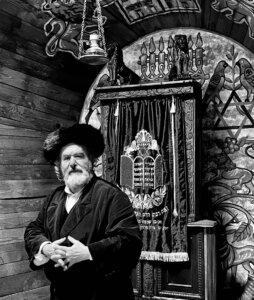
A remarkable scene in Ady Walter’s film Shttl takes place in a Jewish Ukrainian village outside of Kiev on June 21, 1941, one day before the Nazi invasion, known as Operation Barbarossa.
The Rebbe, played by the always excellent Saul Rubinek is the voice of reason; he is a thoughtful, complex, contradictory and conflicted character. He does not raise his voice, he takes time to consider what to say as he himself struggles to respond to whatever factionalism arises within the community. His sad eyes are expressive. He repeatedly rubs his thumb across his fingers. This is a master class in consummate acting.
The mostly black-and-white Yiddish language film, currently playing in New York at New Plaza Cinemas, spans 24 hours in the shtetl, whose residents remain clueless of the impending doom despite the presence of the Russian Army that has already infiltrated the village. Nonetheless the cracks are surfacing within the community. Intense arguments abound on such issues as workers rights and whether to abandon religion or commit to a devoted life. One female character espousing the need for women’s rights, anticipates the future struggle of feminism in the face of patriarchy.
At its core, the film explores Jewish identity, unity and survival. The Rebbe understands factionalism yet remains implacable as he urges the townspeople to be Talmudic in their judgments, tolerant and compassionate. He describes true Jewishness as the color gray, allowing for and even respecting differences of opinion, purpose and worldview.
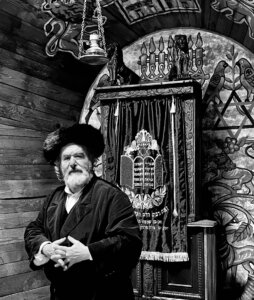
For, the Rebbe, Jews must always remain unified on some profound level. “Unity is the only thing that matters in the battle against evil,” he asserts. His second tenet is faith in God. Doubt can never enter the picture.
The central character, Mendele (Moshe Lobel in a nicely understated performance) is an aspiring filmmaker, who has long since left the shtetl to join the Red Army in Kyiv. But he returns home along with his best friend, a non-Jewish Ukrainian named Demyan (Petro Ninovskyi), so he can elope with his true love, Yuna (Anisia Stasevich), the child of The Rebbe.
But Yuna is already engaged through an arranged marriage to Folie (Antoine Millet), a cruel, autocratic Hasid who, despite his alleged religiosity, is petty, sly, cunning and ultimately violent.
Mendele remains torn between his ambitions embodied by the cosmopolitan outside world and the restrictive, confined shtetl where he is still deeply rooted. And he can’t help but feel connected to his estranged father, whom he holds responsible for the suicide of his late mother who, like Mendele, was also an outlier.
The film was shot in Ukraine in 2021 at the height of COVID-19 restrictions and at the very moment the Russian invasion was looming. The set, including a synagogue, was supposed to be converted into a museum honoring Ukraine’s Jewish past. But in the end, the Russian forces destroyed the whole shtetl set and the land was mined. Now that the president of Ukraine is a Jew at the very same time antisemitism is surging across the globe and Ukrainians and Jews are both under assault, the parallels and irony are almost implausible.
Walter, a documentary film director making his feature debut, has said his mission was to bring the shtetl universe that was totally wiped out during the Holocaust back to life. The title Shttl with its missing “e” references the 1969 novel, La Disparition by Georges Perec, whose mother died in Auschwitz. In Perec’s fictional work the letter “e” never appears in Shttl, its absence mirroring the emptiness, the void, the loss.
In this film, unlike such Holocaust classics like Schindler’s List, The Pianist, Son of Saul, death, despair, and hopelessness are not yet part of the collective experience. This is life prior to the Holocaust in an ethnically diverse community overflowing with purpose and hope for the future. Many Jews and gentiles enjoy camaraderie, and Yiddish and Ukrainian are both spoken.
Shtll’s cinematic technique is evocative, specifically the way scenes of recollection seamlessly morph into color — Mendele recalls his life as a yeshiva boy and the time his gentle mother gave him a baby rabbit as a pet. The colorful flashbacks suggest the past is so much more vivid than the black-and-white present.
Nevertheless, I found the film problematic. Though it has been praised for its one-shot cinematic approach, which purports to make the movie more immediate, real and immersive for the viewer, the set and the inconsistent performances made it feel more like a filmed stage play to me. And, more importantly, the characters don’t seem like actual human beings as they do spokespersons for various political, philosophical,and religious viewpoints. The quirky folkloric figures don’t help. There are two holy fools of various stripes — a beatific deceased mom who appears as a spectral figure, and my favorite, the butcher who has become a vegetarian.
Admittedly, my image of shtetl life is informed by a Fiddler on the Roof ethos and, by extension, the stories of Sholem Aleichem which presents a largely impoverished, insular and marginalized world, even if its residents don’t see themselves as disenfranchised. But in Shtll, the youthful characters are self-confident in their speech, gestures, and especially their wide-stride, swaggering gaits. They seemed jarringly secular and contemporary to me.
In one scene, our three protagonists, including Yuna, are happily passing back and forth a bottle of booze, each guzzling from the communal cap. The provincial virginal daughter of The Rebbe in a 1941 shtetl? Really?
In the end, though, the film makes a 180-degree turn that nearly eradicates its flaws. Mendele, Demyan, and Yuna have spent the night in the forest and have fallen asleep content in their certainty that at sunrise they will be embarking on their great adventure to freedom.
As dawn breaks and the sun begins to emerge over the trees. Mendele hears gunfire and spies the battalions of Nazis entering the shtetl en masse. The obliteration that will follow is clear. The respective politics, philosophies, not to mention petty jealousies, indeed, all the internecine fighting on the one hand and the moments of jubilation on the other have become totally meaningless. The realization is devastating.
The post An idyllic Jewish village, full of life and hope, just hours before its utter annihilation appeared first on The Forward.
Uncategorized
Pardoned Jan. 6 protester Jake Lang throws chocolate coins, Nazi salute during anti-AIPAC demonstration in DC
(JTA) — Pardoned Jan. 6 protester Jake Lang staged an antisemitic demonstration on Sunday outside of the headquarters of the pro-Israel lobby AIPAC where he threw chocolate coins and gave a Nazi salute.
As he stood before a banner reading “Make Jerusalem Christian Again,” Lang made a series of threats against AIPAC-funded politicians and peddled a slew of antisemitic tropes, including the Great Replacement Theory, which holds that Jews are orchestrating mass immigration.
“White people in America, you will be replaced, and your children will be Black Muslims if you don’t stand up now,” said Lang, according to a video of the protest posted on X by journalist Ford Fischer. “AIPAC is one of the main components to the people at the head of Hollywood that are brainwashing your children to vote Democrat, to take your guns and to take your freedom. It’s time we fight back.”
VIDEO THREAD: Pardoned January 6er Jake Lang held a “Crusader” rally outside AIPAC Sunday afternoon, throwing (chocolate) gold coins at attendees dressed as politicians and suggesting “their Jewish money” has caused a “brownification of America.”
A couple counter-protesters… pic.twitter.com/CHsoj9ETu2
— Ford Fischer (@FordFischer) January 4, 2026
The demonstration hosted by Lang, who is currently vying for a Senate seat in Florida, comes as watchdogs have warned that alt-right figures are increasingly finding a foothold within mainstream conservative politics.
In recent months, far-right influencers like Lang, including livestreamer Nick Fuentes, have garnered mainstream attention within the Republican party, a trend that has sparked outcry among both Jewish and non-Jewish Republicans. But Vice President JD Vance has indicated that while he opposes antisemitism, he is not inclined to draw a line against rising antisemitism in his party. At the same time, AIPAC, which Lang targeted, has become anathema in both parties as support for Israel has plummeted in recent years.
Lang’s Senate candidacy in Florida is not considered serious. He has raised very little money in his quest to unseat an incumbent who has President Donald Trump’s support.
But Lang has benefited from Trump in the past as well. He had spent four years in federal custody in Washington, D.C., after being charged for allegedly beating a police officer with a bat during the Jan. 6, 2021, Capitol protest when Trump pardoned 1,600 people charged with crimes committed by his supporters that day. Earlier this year, he went free.
Since then, Lang has frequently staged incendiary protests in other cities across the country. In November, Lang travelled to Dearborn, Michigan, where he attempted to burn a Quran, the central religious text in Islam, and slapped bacon on it. (He later filed a lawsuit against the city claiming that police did not intervene in a confrontation with counter-protesters.)
During the protest Sunday, Lang also made a series of racist remarks towards immigrant children, including that “they’re anchor babies sent in as chemical weapons by the Talmudic Jews.”
Lang also warned that lawmakers who have received AIPAC donations would be “hung for treason.”
“Congressmen and women that have been taking AIPAC money, we suggest you stop now before the Crusades really start, you will be on the menu,” said Lang. “These people have sold our country out. Treasonous traders will be hanging from the gallows rightfully and just-fully prosecuted and hung for treason.”
Later, when asked by a person in the crowd whether he believed that “the Holocaust happened,” Lang replied, “Not at that level, no.”
Before leading his group away from the AIPAC headquarters, Lang gave a final Nazi salute and said, “That’s the APAC building right there. White Christian men are not gonna sit around while you turn our children into a bunch of n—er lovers.”
The post Pardoned Jan. 6 protester Jake Lang throws chocolate coins, Nazi salute during anti-AIPAC demonstration in DC appeared first on The Forward.
Uncategorized
She helped rescue the Torahs from their burning synagogue. A year later, Pasadena’s mishkan is thriving.
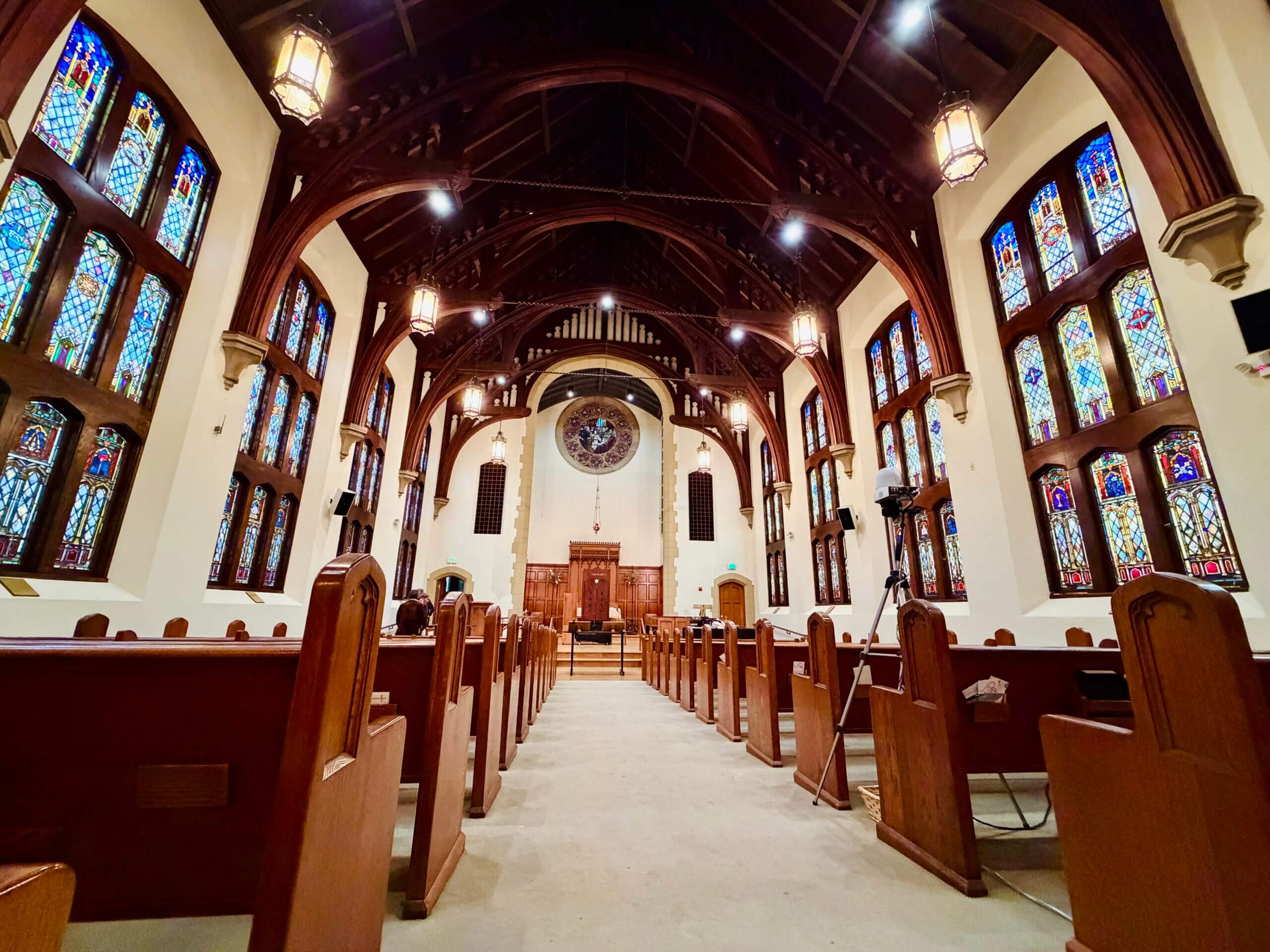
PASADENA — A year after fire reduced the Pasadena Jewish Temple and Center to ash, Cantor Ruth Berman Harris stands in the rain on the empty lot where it once stood. Beneath her boots, the ground is slick; above her, the San Gabriel Mountains fade into fog — the inverse of the dry, wind-driven night when flames tore through this block.
As smoke filled the building, and ash began falling in the parking lot one year ago, Berman searched for her husband through the darkness, calling out to make sure the Torahs were being carried out. Joined by the synagogue’s president and custodian, they worked quickly, loading the 13 scrolls into two cars as the fire, a beast consuming Los Angeles, roared closer. By night’s end, the building was destroyed, the flames claiming it all.
Over the past year, the synagogue has been doing the work of recovery in plain sight and in borrowed space. It has not seen a collapse in membership; as many families have joined since the fire as in the year before it. The calendar has remained full. In 2025, the shul celebrated 25 bar and bat mitzvahs — one nearly every other week — even as services moved to a church chapel across town. And as the community continues to grieve what was lost, leaders are already imagining a rebuilt synagogue designed to better reflect how the congregation lives and gathers now.
For Berman, 55, that rhythm felt familiar.
She grew up in Buenos Aires and lived through two acts of mass violence that targeted the Jewish community there — the 1992 bombing of the Israeli embassy and the 1994 bombing of a Jewish community center, which killed 85 people, including friends of hers. In those moments, she was the one making sandwiches for rescue workers, helping others absorb shock.
The Eaton Fire that razed Pasadena was different.
“What surprised me,” she said, “was how loving and caring and strong and vibrant a community can be in the midst of tragedy. There was no doubt that we were going to be OK.”
Over the past year, she has watched people return to Jewish life who had once drifted away from it — not out of fear, but out of need.
“It surprised me how relevant a Jewish community can be in times of crisis,” she said. “I knew it from books. I had never experienced it.”
Some losses, she knows, cannot be replaced. On her office walls hung artwork painted by her mother. On her desk, a constant presence was a prayer book she had studied from since cantorial school, filled with notes, highlights, and the handwriting of her teachers.
“I can buy another siddur,” she said. “But I can’t replicate their writing.”
She speaks plainly about the trauma. Nightmares. Compartmentalization. What she calls a lockbox she has learned to keep sealed so she can continue doing her job. Only recently, she said, has she begun to feel steady enough to open it — helped by the arrival of a permanent rabbi, and by the knowledge that the community is no longer just surviving.
A temporary sanctuary
Shabbat arrives inside a side chapel at the First United Methodist Church, where the Pasadena Jewish Temple and Center has been gathering since the fire.
During Sukkot, the church opened its courtyard for a sukkah. Shul congregants found themselves explaining the holiday — its temporary walls, its invitation to dwell with uncertainty — to church members who stopped to ask questions. What might once have been an accommodation became, instead, a point of exchange: Jewish ritual practiced openly, and neighbors eager to understand it.
The chapel feels like a sanctuary in its own right. There are no crosses on the walls. The space is rectangular and airy, with wood arches vaulting toward the ceiling like the hull of an inverted ship. Gold-rimmed stained-glass windows run the length of the room on both sides. One of them, inexplicably, bears a purple menorah.
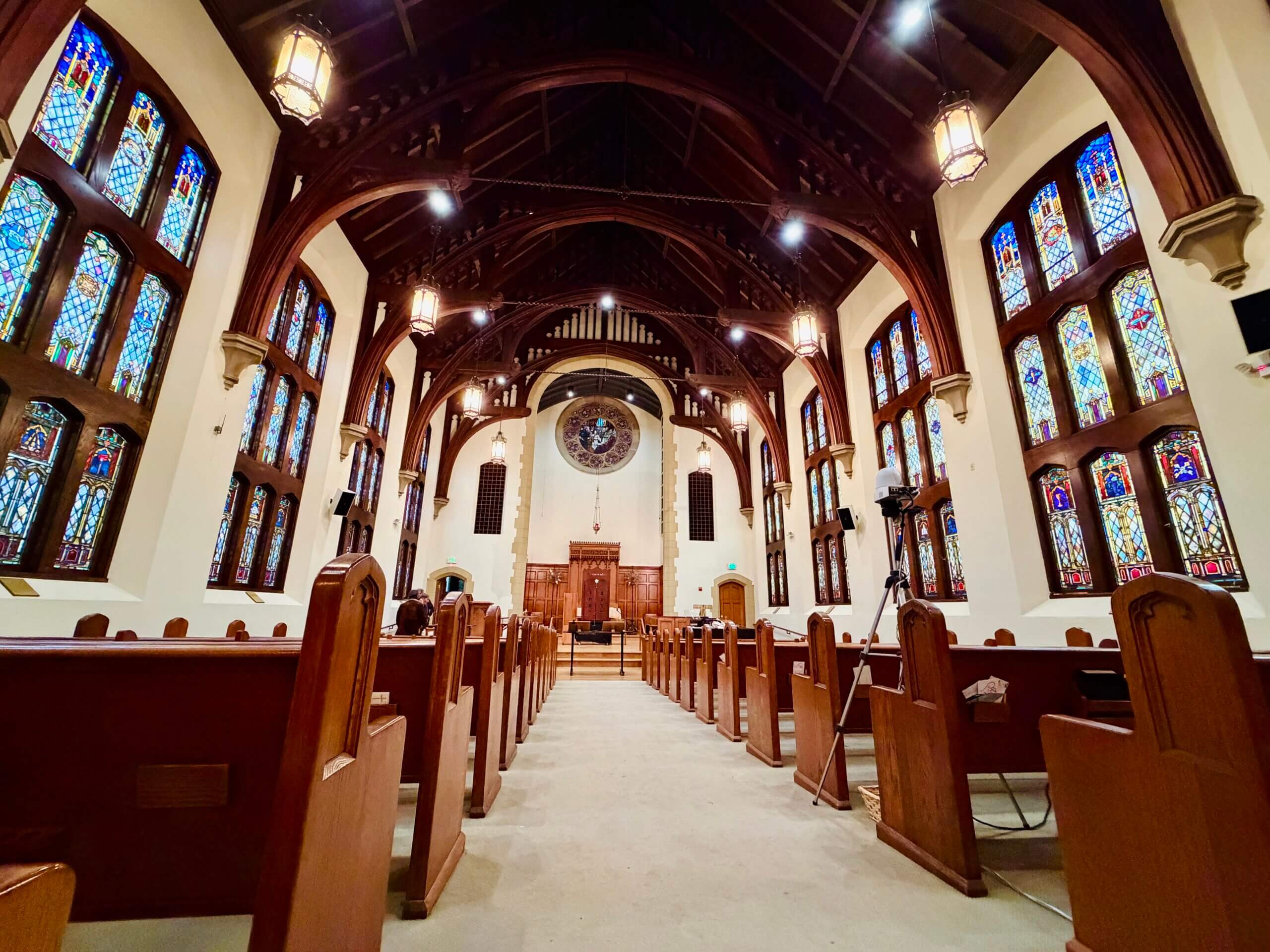
Only small details reveal the building’s Christian life: a New Century Hymnal tucked into the back of each pew, a Bible containing both the Old and New Testaments, a small tithing envelope resting beside it.
About 100 people fill the pews on Saturday morning. At the front of the chapel, Berman and Rabbi Joshua Ratner lead services alongside a bat mitzvah girl, while a guitarist and mandolin player keep the room humming.
The portable ark behind them has an unlikely backstory. It was crafted decades ago by a Los Angeles pediatrician (and father of Forward reporter Louis Keene) who had built it for his own shul which, at the time, was temporarily meeting at a Baptist church.
In recent years, the ark sat unused in the doctor’s garage. After the January 2025 wildfires, the family donated it to Pasadena — carried in and out of the church chapel each week, suddenly suited to a congregation without a permanent home.
For a year now, the Pasadena Jewish Temple and Center has lived this way. “It’s a mishkan,” Ratner said. “A traveling tabernacle.”
As the service continues, Ratner delivers the sermon. He began the job in August, months after the fire, at a moment when the synagogue no longer had a building to offer him — only a congregation in flux.
Ratner, 50, spent his early career as a lawyer before pivoting to the pulpit. He applied for the Pasadena job before the fire, drawn by what he had heard about the community. When the building was destroyed, he thought the search would be called off.
“I assumed that would be the end of it,” he said.
Instead, synagogue leaders doubled down. They wanted a rabbi not after recovery, but in the middle of it.
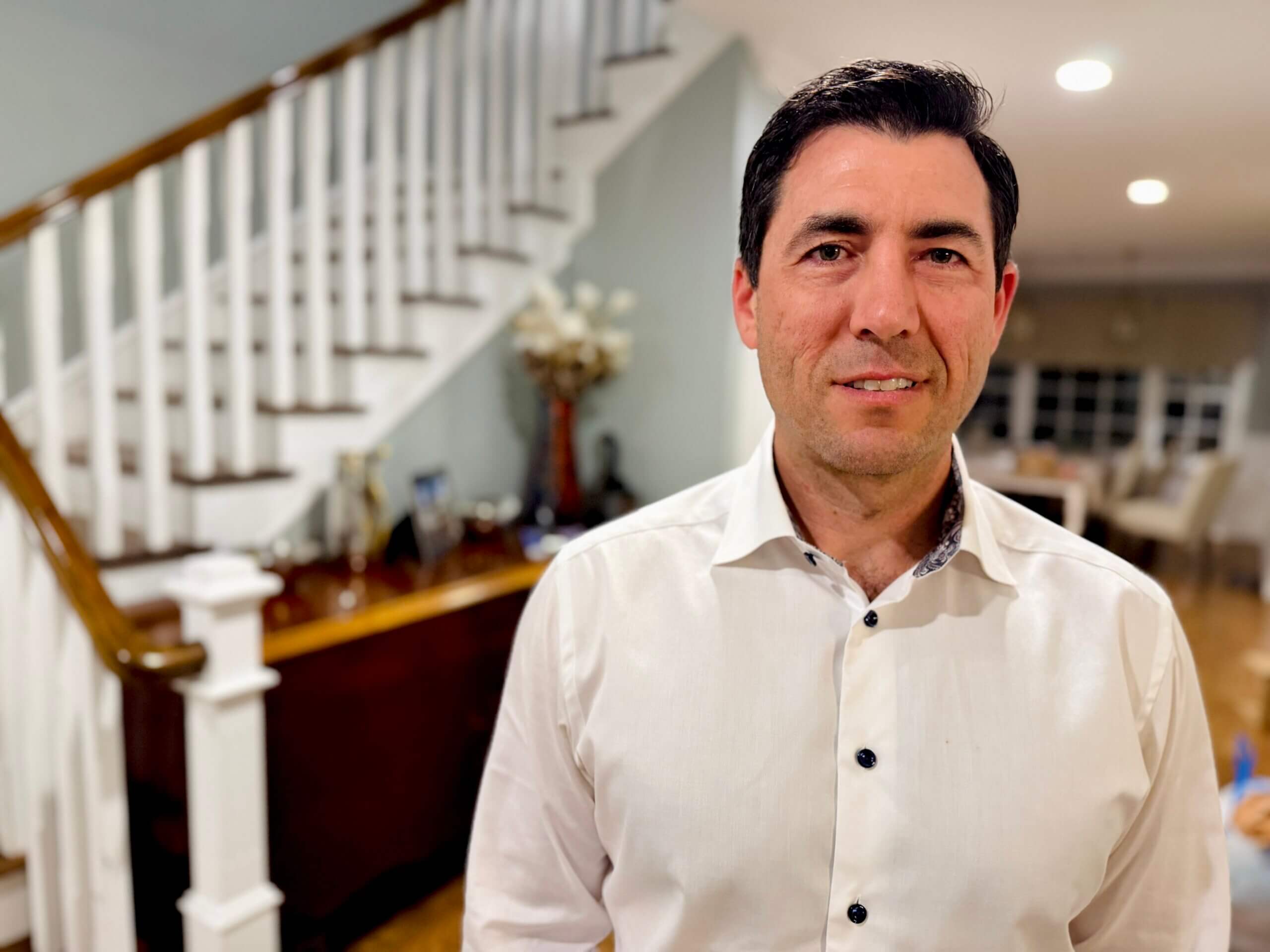
When Ratner visited Pasadena after the fire, he was struck by what he found. Hundreds of people filled Friday night and Shabbat morning services — not out of obligation, but solidarity.
The community, Ratner sensed, was grieving, but not frozen. “There’s no doubt or existential fear,” he said. “While we’re still mourning what we lost, we’re already morphing into the future.”
Since his arrival, the momentum has held. “Every week almost feels new,” Ratner said. “Like a simcha.”
A family without a home
For some of the shul families, the losses were not only communal.
In neighboring Altadena, Heather Sandoval Feng and her husband, Oscar, stand on the front steps of what used to be their home. The fire left behind a pile of rubble and a concrete staircase leading nowhere.
Three weeks after the fire destroyed their house, their daughter Hannah became a bat mitzvah.
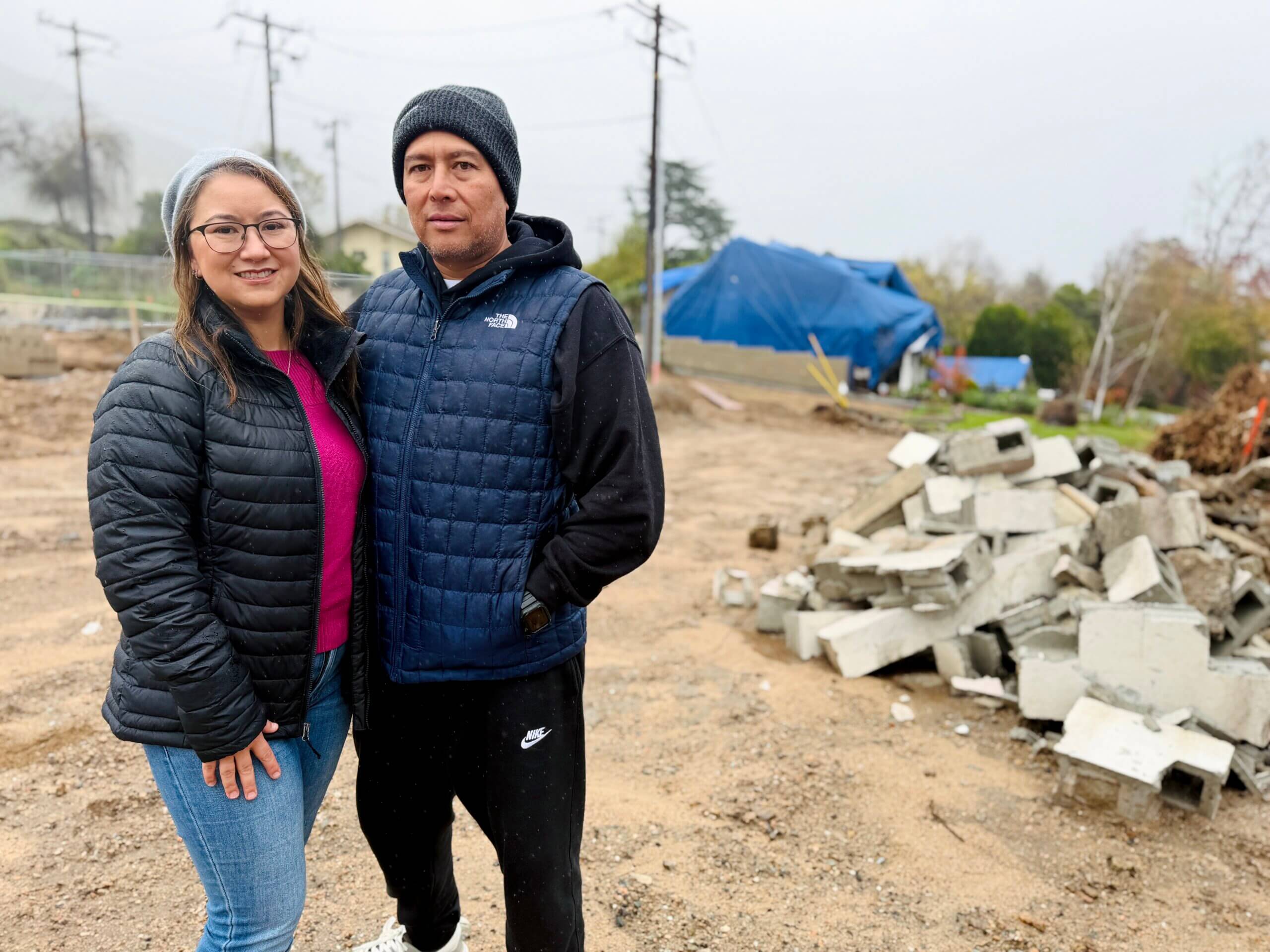
Like the congregation itself, the family was displaced. They moved in with Heather’s parents nearby. Life became provisional — borrowed bedrooms, borrowed routines, borrowed time. And yet Hannah’s bat mitzvah went ahead as planned, held in the church chapel where the Pasadena Jewish Temple and Center now gathers each Shabbat.
“There was something strangely comforting about that,” Heather said. “The synagogue had lost its home. We had lost ours. We were going through it together.”
Oscar described the year as one long exercise in adjustment — learning how to live without the assumption of permanence. “We’ve had to be a little nomadic,” he said, looking over as their son, Noah, 10, played in the dirt where his bedroom once stood.
The bat mitzvah ceremony became a life lesson — not just about Torah, but about continuity without certainty. “It turned into a teachable moment,” Oscar said.
What sustained them, both parents said, was the congregation’s steadiness. Tutors kept showing up. Shabbat kept coming. People checked in — not performatively, but persistently. The synagogue did not treat their family as a separate tragedy. It folded them into its own.
“There was never a question of whether things would still happen,” Heather said. “The answer was always: Of course they will.”
Holding steady and looking ahead
In the months after the fire, synagogue leaders worried about what displacement might do to membership. Instead of a drop-off, the numbers told a different story. Since the fire, the Pasadena Jewish Temple and Center has welcomed 49 new families — roughly the same number it added the year before. A handful of families have moved away, some because of the fire itself, but overall membership has remained remarkably consistent, hovering around 430 families.
An added bonus: Some relatives who flew in from out of town for bar and bat mitzvahs found themselves so moved by the congregation that they later joined it themselves.
What surprised Melissa Levy, the synagogue’s executive director, was not just the endurance, but the momentum behind it. Families kept calling. Local Jews who were not members wanted to now join the congregation.
“It’s amazing,” she said, “but it’s also a testament to how strong this community already was.”
That strength has been built over more than a century.
Founded in 1921 as Temple B’nai Israel, the congregation moved onto its current property in 1941, a campus of Mission Revival–style buildings arranged in a U-shape — a midcentury synagogue just beyond the urban sprawl of Los Angeles that had expanded over decades to include classrooms, playgrounds, and a social hall. At one point, it even had a swimming pool. During World War II, the synagogue hosted USO-style dances for servicemen stationed nearby.
Members have included NASA engineers, Caltech professors, and those who built their dreams among the stars. “I used to joke that growing up in Pasadena, our shul had doctors, lawyers and rocket scientists,” said Rabbi Alex Weisz, whose family has been members for generations.
As Jewish demographics shifted, the congregation absorbed others — merging with Shomrei Emunah and later Shaarei Torah — eventually becoming the singular Conservative synagogue serving the western San Gabriel Valley.
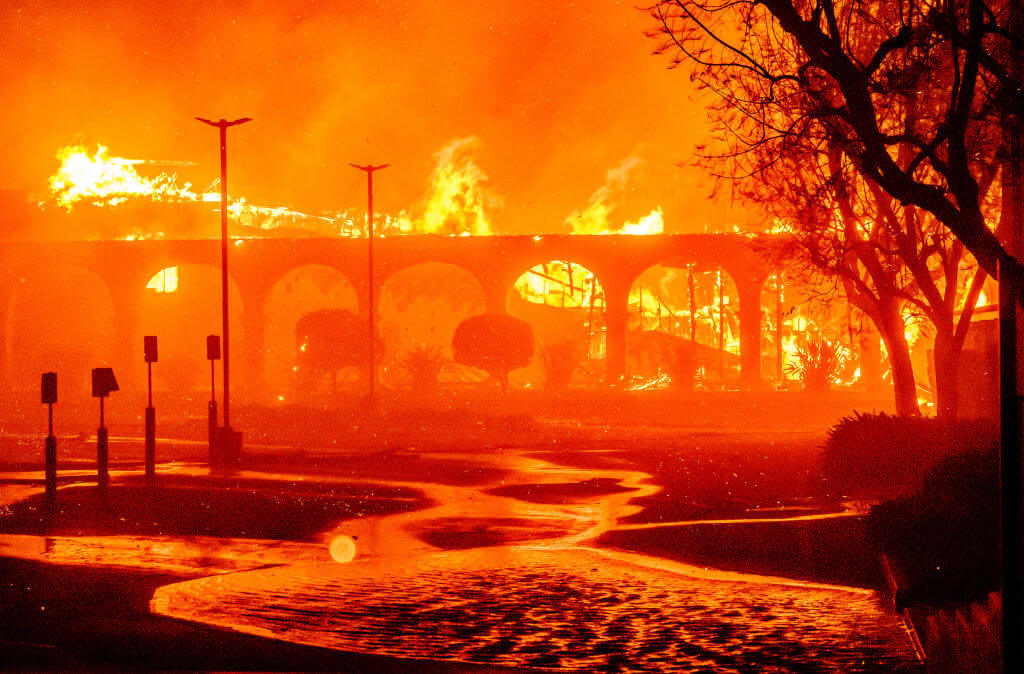
That history now informs the future, and what rises in its place will not be a replica of what was lost. The new building will be more intentional: fewer walls, more flexibility, and spaces designed around how congregants actually spend time together now.
Plans call for open gathering areas where parents can linger when their children are in classes — places to work, talk, or simply stay — rather than treating the synagogue as a drop-off point. There will be more glass and fewer corridors, designed to draw the San Gabriel Mountains into view. Outdoor areas are meant not just for overflow, but for prayer and meditation — quiet spaces that look outward, toward the hills that rise behind Pasadena.
“We were fitting a circle into a square,” Levy said. The new building is being imagined as a place where different generations can overlap rather than pass through on separate schedules.
The goal is not grandeur, but usability. A synagogue that can hold worship and study, celebration and stillness — and that reflects a community that has learned, over the past year, how to gather without relying on walls at all.
The scale of what lies ahead is substantial. Rebuilding is expected to cost tens of millions of dollars. Insurance will cover roughly half of that amount — money that was paid out quickly and is already in an account collecting interest — but the rest will need to be raised by the congregation itself. The cost is immense, especially for middle-class Pasadena, but leaders describe it as something to be faced, not feared.
They hope to open the new building by the High Holidays of 2028 — not as a return to what was lost, but as an expression of what the community has become. For now, those plans exist alongside grief. But Jewish life continues — weekly, seasonally, insistently.
Asked what it feels like to stand at the site of the fire a year later, Cantor Berman pauses.
“I don’t really have words for it,” she said.
Rain dots the cracked pavement beneath her feet, darkening the outline of the lot where the synagogue once stood.
After the fire — after the Torahs had been rescued and the building reduced to rubble — she returned to the site and took one small thing that was still standing. Not a ritual object. Not a book. It was the sign from her parking space — Reserved for the Cantor — something ordinary that had marked the rhythm of returning to the same place, day after day.
There were other losses, she said. Some she remembers clearly. Others she does not.
“The things I don’t remember having,” she said, “will haunt me forever.”
The post She helped rescue the Torahs from their burning synagogue. A year later, Pasadena’s mishkan is thriving. appeared first on The Forward.

